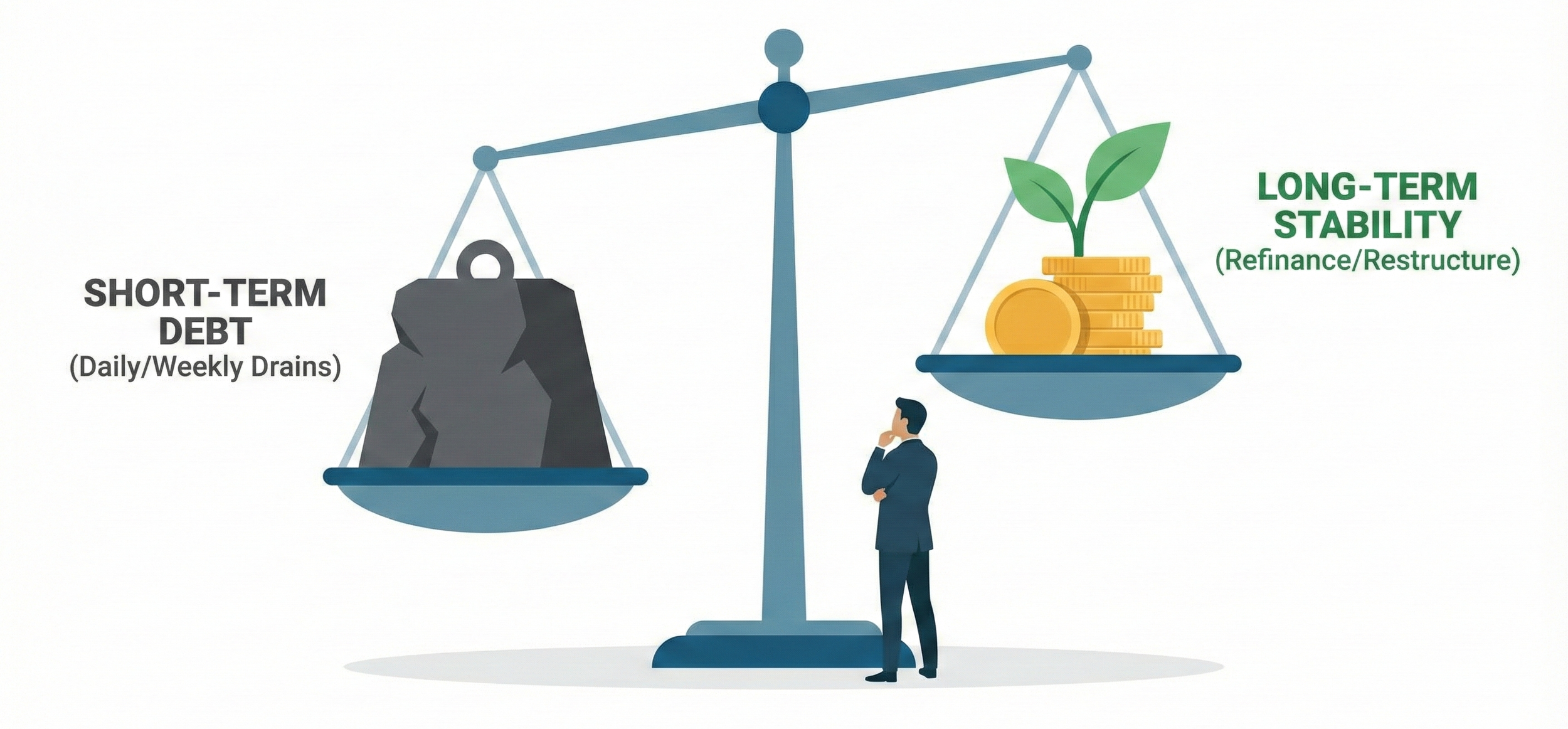Are Your Business Debt Payments Too High?
As a small business owner, you wear countless hats.
You are the CEO, the head of marketing, the chief custodian, and often, the lead worrier.
One of the heaviest burdens to carry is business debt.
While business debt is a powerful and often necessary tool for growth—funding new equipment, expanding your location, or managing gaps in cash flow—it can quickly transform from a helpful partner into a crushing weight.
When business debt payments become unmanageable, they don’t just strain your finances; they suffocate your opportunities, drain your energy, and put the very survival of your business at risk.
This article is a guide to help you diagnose the health of your business’s debt load, understand its true cost, and chart a course back to financial stability and peace of mind.
The Constant Weight on Your Shoulders
Before you even look at a spreadsheet, you can often feel when debt is becoming a problem.
It’s the low-grade anxiety that hums in the background of your day.
It’s the knot in your stomach when you see an envelope from a lender in the mail.
It’s the sleepless nights spent mentally juggling accounts payable and receivable, wondering if you’ll have enough to cover payroll and the loan payment that’s due on Friday.
This psychological toll is the first and most personal sign that your debt payments may be too high.
This feeling of being trapped can lead to a state of paralysis.
You might find yourself making decisions out of fear rather than strategy.
Instead of investing in a promising new marketing campaign, you hoard every dollar.
Instead of hiring a much-needed employee to spur growth, you try to do everything yourself, leading to burnout.
The debt becomes more than just a line item on your balance sheet; it becomes a shadow partner in your business, one that has a say in every decision you make, and its vote is always for austerity and caution.
Recognizing this emotional and mental strain isn't a sign of weakness; it's the first critical step toward acknowledging the problem and taking back control.
Listening to the Whispers:
Early Warning Signs
Long before the bank sends a formal notice, your business will send up its own warning flares.
These are the subtle, day-to-day operational shifts that signal a growing cash crunch caused by burdensome business debt service.
Are you increasingly relying on your line of credit to cover routine operating expenses like inventory or utilities?
This is a classic sign that your core operations aren't generating enough cash to stand on their own after debt payments are made.
Another significant red flag is a change in your payment habits.
You might find yourself "managing" your accounts payable by strategically delaying payments to vendors.
The thirty-day terms stretch to forty-five, then sixty.
While this can feel like a clever short-term fix, it erodes trust with your suppliers and can harm your business’s reputation, potentially leading to stricter payment terms or a refusal to do business with you in the future.
Similarly, if making payroll feels like a monthly miracle that requires a last-minute cash scramble, it’s a clear indication that your fixed debt obligations are leaving you with no margin for error.
Paying your team should be a predictable expense, not a recurring crisis.
Finally, an aversion to looking at your own financial statements is a behavioral warning sign.
If you’d rather not know the numbers, it’s often because you intuitively sense the news is bad.
From Gut Feeling to Hard Data:
Key Financial Ratios
While gut feelings are important, you need objective data to truly understand your debt situation.
A few key financial ratios can act as a diagnostic tool, providing a clear, unbiased picture of your company's financial health.
These are the very same metrics that lenders use to evaluate your business, so understanding them gives you a powerful advantage.
The first essential metric is the Debt-to-Asset Ratio.
This ratio tells you what percentage of your company's assets are financed through debt.
It's a measure of leverage and risk.
The formula is:
Debt-to-Asset Ratio = Total Debt / Total Assets
A lower ratio is generally better, indicating that the business owns a greater portion of its assets outright.
While industry standards vary, a ratio below 0.5 is often considered healthy.
A number approaching 1.0 suggests that the vast majority of your assets are financed by creditors, which can be a precarious position.
Perhaps the most critical ratio for evaluating your payments is the Debt Service Coverage Ratio (DSCR).
This measures your ability to cover your total debt payments out of your operating income. Lenders watch this ratio like a hawk.
The formula is:
DSCR = Net Operating Income / Total Debt Service
Here, "Net Operating Income" is your revenue minus operating expenses (but before interest and taxes), and "Total Debt Service" includes all principal and interest payments for the period.
A DSCR of less than one means you are not generating enough income to cover your debt payments—a five-alarm fire.
Most lenders look for a DSCR of at least 1.25, meaning you have a twenty-five percent cash cushion after making your payments.
A healthy business should aim for this or higher.
The Unseen Costs of Excessive Debt
The strain of high business debt payments extends far beyond your bank account.
It creates significant, often invisible, opportunity costs that can cripple your business’s long-term potential.
When every spare dollar is allocated to servicing business debt, there is nothing left for innovation.
The research and development for a new product line, the upgrade to more efficient software, or the training to upskill your team are all put on the back burner.
Your business gets stuck in the present, unable to invest in its future.
This financial inflexibility also destroys your agility.
The business world is dynamic; new opportunities and threats emerge constantly.
A healthy business can pivot quickly to take advantage of a competitor’s misstep or adapt to a shift in consumer demand.
A debt-laden business, however, is a ship with a broken rudder.
It lacks the capital to launch a new marketing campaign, purchase inventory for a surprise large order, or weather a temporary sales slump.
This inability to react makes the business incredibly vulnerable.
Furthermore, it damages relationships.
Employees may sense the instability and seek more secure employment elsewhere.
Suppliers, as mentioned, may tighten credit terms.
Even your ability to focus as a leader is compromised, as you spend more time managing creditors than managing growth.
The Rearview Mirror: How Did We Get Here?
To solve a problem effectively, you must first understand its root cause.
This isn't an exercise in assigning blame but a crucial diagnostic step to prevent history from repeating itself.
Businesses can find themselves over-leveraged for several reasons.
One common path is uncontrolled expansion.
Fueled by early success, a business might take on significant debt to open new locations or launch new products too quickly, without ensuring the underlying business model can support the increased overhead and debt service.
Growth becomes the goal, rather than profitable, sustainable growth.
Another frequent culprit is a mismatch between the type of debt and its use.
For example, using a short-term, high-interest line of credit to purchase a long-term asset like a major piece of equipment is a recipe for a cash flow crisis.
The asset won’t generate revenue fast enough to pay off the expensive, short-term financing.
The proper approach is to match the loan term to the asset's useful life—long-term debt for long-term assets.
In other cases, an unexpected economic downturn or a major industry shift can slash revenues, leaving a previously manageable debt load suddenly unbearable.
Finally, some businesses are simply undercapitalized from the start, relying too heavily on debt instead of equity from the outset, leaving no room for error.
Taking a Breath: Your Immediate Action Plan
Once you’ve identified that your debt payments are too high, the instinct can be to panic.
It’s essential to resist this urge and instead move into a calm, methodical mode of action.
Your first step is to stop digging the hole deeper.
Immediately freeze all non-essential spending.
This means putting a hold on any purchases or investments that are not absolutely critical to the day-to-day generation of revenue.
This is a temporary, emergency measure to preserve cash.
Next, it’s time for a complete financial triage.
Gather every single document related to your debts: loan agreements, credit card statements, and lines of credit.
Create a master spreadsheet—a "debt inventory"—that lists each creditor, the total amount owed, the interest rate, the monthly payment, and the loan term.
This comprehensive overview is your map.
At the same time, create a brutally honest, forward-looking thirteen-week cash flow projection.
This forecast should detail every dollar you realistically expect to come in and every dollar that needs to go out.
This combined view of your debt obligations and your real-world cash flow will provide the unvarnished truth of your situation and form the bedrock of your turnaround plan.
Reshaping Your Obligations:
Debt Restructuring Strategies
With a clear picture of your financial situation, you can now proactively explore strategies to restructure your obligations and make your payments more manageable.
The first and often most effective approach is direct communication with your lenders.
Bankers and creditors are not your enemies; they have a vested interest in you succeeding so they can get their money back.
A default is a costly and time-consuming process for them.
Schedule a meeting, present your honest cash flow projections and your plan to stabilize the business, and come with a specific request.
This could be a temporary forbearance (a short-term pause on payments), a request to pay interest-only for a period, or a longer-term modification to extend the life of the loan, which would lower your monthly payments.
If you have multiple sources of high-interest debt, such as credit cards or short-term loans, consider debt consolidation or refinancing.
A consolidation loan combines multiple debts into a single new loan, ideally with a lower overall interest rate and a single, more manageable monthly payment.
An SBA loan, for example, can often be used for this purpose and may offer favorable terms.
Refinancing is similar but typically involves replacing one large loan with a new one on better terms.
Be aware that these options can sometimes extend the repayment period, meaning you might pay more in total interest over the life of the loan, but the immediate relief to your monthly cash flow can be the lifeline your business needs to survive and recover.
Turning the Tide: Aggressive Cash Flow Generation
Reducing your business debt payments is only one side of the equation.
The other, equally important side is increasing the cash available to make those payments.
It’s time to put your revenue generation and expense management under a microscope.
Start by examining your accounts receivable.
Are you invoicing promptly and following up on overdue payments diligently?
Tightening your collection process can be one of the fastest ways to inject cash into your business.
Consider offering a small discount for early payment to incentivize your customers.
Next, look at your assets. Is there any underutilized equipment, old inventory, or other assets that could be sold?
A one-time cash infusion from liquidating these items can provide critical breathing room.
On the revenue side, think about short-term promotions or special offers you could run to drive a quick burst of sales.
Can you bundle services or offer a discount on a high-margin product?
Simultaneously, conduct a thorough review of every single business expense.
Go beyond the obvious cuts and question everything.
Do you need that premium software subscription, or will a cheaper alternative suffice?
Can you renegotiate with your landlord or other vendors?
Trimming even small, recurring expenses can add up significantly over time, freeing up precious cash for debt service.
Building a Moat:
Proactive Debt Management for the Future
Once you have navigated the immediate crisis, the goal is to ensure you never find yourself in this position again.
This requires a fundamental shift to a proactive and strategic approach to debt.
The first rule of smart borrowing is that all debt must have a clear purpose and a measurable return on investment.
Before signing any loan document, you should be able to clearly articulate how this debt will generate more revenue than it costs to service.
Avoid taking on debt for vanity projects or speculative ventures.
It's also crucial to match the type of financing to its purpose.
Use long-term loans with fixed interest rates for major investments like real estate or essential equipment.
Use a revolving line of credit, which is meant to be paid down quickly, for managing short-term fluctuations in working capital, not for funding permanent operations.
Establish an internal "debt ceiling" for your business based on the financial ratios discussed earlier.
Decide on a maximum Debt-to-Asset Ratio and a minimum Debt Service Coverage Ratio that you will not breach.
This creates a financial guardrail that prevents you from becoming overextended.
Finally, the single most powerful defense against a debt crisis is a robust cash reserve.
Strive to build and maintain an emergency fund with enough cash to cover several months of essential operating expenses, including your debt payments.
Your Business, Your Future: Taking Command
Facing up to a difficult debt situation is one of the most challenging experiences a business owner can have. It can feel isolating and overwhelming.
However, recognizing the problem and methodically working through it is an act of profound leadership.
Business Debt is a tool, and like any powerful tool, it demands respect, planning, and careful management.
When used wisely, it can build empires.
When mismanaged, it can bring them down.
By moving from a state of anxious avoidance to one of informed action, you transform yourself from a victim of your circumstances into the architect of your recovery.
The journey begins with an honest assessment—first of the qualitative pressures, then of the hard numbers.
It proceeds with a clear-eyed plan to restructure your obligations and aggressively manage your cash flow.
And it culminates in a new, disciplined approach to finance that will protect your business for years to come. You are the captain of your ship.
The waters may be rough, but you have the tools and the ability to navigate through the storm, right the vessel, and set a new course toward a more stable, profitable, and resilient future.
WHAT IS THE BEST AND SAFEST WAY FOR YOUR BUSINESS TO DEAL WITH HIGH BUSINESS DEBT PAYMENTS?
It is NOT by stopping ACH payments.
It is NOT by taking on another business loan.
It is NOT ALWAYS a Refinancing
It is NOT by entering into a debt settlement program.
Find out the BEST strategies to get your Business back to where it was



















